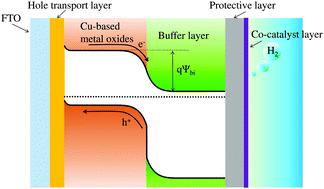当前位置:
X-MOL 学术
›
Energy Environ. Sci.
›
论文详情
Our official English website, www.x-mol.net, welcomes your
feedback! (Note: you will need to create a separate account there.)
Earth-abundant Cu-based metal oxide photocathodes for photoelectrochemical water splitting
Energy & Environmental Science ( IF 32.4 ) Pub Date : 2020-09-10 , DOI: 10.1039/d0ee02397c Changli Li 1, 2, 3, 4 , Jingfu He 1, 2, 3, 4 , Yequan Xiao 4, 5, 6, 7 , Yanbo Li 4, 5, 6, 7 , Jean-Jacques Delaunay 8, 9, 10, 11
Energy & Environmental Science ( IF 32.4 ) Pub Date : 2020-09-10 , DOI: 10.1039/d0ee02397c Changli Li 1, 2, 3, 4 , Jingfu He 1, 2, 3, 4 , Yequan Xiao 4, 5, 6, 7 , Yanbo Li 4, 5, 6, 7 , Jean-Jacques Delaunay 8, 9, 10, 11
Affiliation

|
Photoelectrochemical (PEC) solar-fuel conversion is a promising approach to converting energy from sunlight into storable chemical fuels. The development of low cost, highly efficient, and stable semiconductor-based photoelectrodes is a key step in realizing economically viable PEC energy conversion on a global scale. The p-type Cu-based metal oxides possess a wide range of bandgap values and favorable band edges relative to the water splitting redox couples, thus providing promising candidates for PEC solar conversion applications. However, the improvement of the PEC performance for the binary and ternary copper-based metal oxides is severely hindered by the chemical instability and/or unsatisfactory optoelectronic properties. Thus, a fundamental understanding of the key limitations, improvement strategies, and progress of these materials is critical to design high performance and stable photocathodes. Here, we outline the development of p-type binary and ternary Cu-based metal oxide photocathodes, discuss the merits and major challenges of these p-type materials, and present the latest research effort in modifying the materials towards high-performance photocathodes. The critical strategies that have been successfully employed for Cu2O-based solar cells and photocathodes are emphasized to offer guidelines to advance emerging Cu-based photocathodes. Emphasis is placed on the determination of the faradaic efficiency and onset potential of hydrogen generation for the modified photocathodes to properly evaluate the performance and design tandem devices that achieve bias-free solar water splitting. Furthermore, perspectives regarding emerging issues yet to be addressed for the development of Cu-based metal oxide photocathodes with high photocurrent and photovoltage are also presented.
中文翻译:

用于光电化学水分解的富土铜基金属氧化物光电阴极
光电化学(PEC)太阳能燃料转换是一种将阳光中的能量转换为可存储化学燃料的有前途的方法。低成本,高效,稳定的基于半导体的光电极的开发是在全球范围内实现经济可行的PEC能量转换的关键步骤。相对于水分解氧化还原对,p型Cu基金属氧化物具有宽的能隙值范围和良好的能带边缘,因此为PEC太阳能转换应用提供了有希望的候选物。但是,化学不稳定性和/或令人满意的光电性能严重阻碍了二元和三元铜基金属氧化物的PEC性能的提高。因此,对关键局限性,改进策略,这些材料的进步对于设计高性能和稳定的光电阴极至关重要。在这里,我们概述了p型二元和三元Cu基金属氧化物光电阴极的发展,讨论了这些p型材料的优点和主要挑战,并提出了将材料改性为高性能光电阴极的最新研究成果。已成功应用于铜的关键策略2 O型太阳能电池和光电阴极被强调为发展新兴的Cu基光电阴极提供指导。重点放在确定经修饰的光电阴极的法拉第效率和产生氢的起始电位,以正确评估性能并设计可实现无偏压太阳能水分解的串联装置。此外,还提出了有关新兴问题的观点,这些问题尚待解决,以开发具有高光电流和光电压的铜基金属氧化物光电阴极。
更新日期:2020-10-14
中文翻译:

用于光电化学水分解的富土铜基金属氧化物光电阴极
光电化学(PEC)太阳能燃料转换是一种将阳光中的能量转换为可存储化学燃料的有前途的方法。低成本,高效,稳定的基于半导体的光电极的开发是在全球范围内实现经济可行的PEC能量转换的关键步骤。相对于水分解氧化还原对,p型Cu基金属氧化物具有宽的能隙值范围和良好的能带边缘,因此为PEC太阳能转换应用提供了有希望的候选物。但是,化学不稳定性和/或令人满意的光电性能严重阻碍了二元和三元铜基金属氧化物的PEC性能的提高。因此,对关键局限性,改进策略,这些材料的进步对于设计高性能和稳定的光电阴极至关重要。在这里,我们概述了p型二元和三元Cu基金属氧化物光电阴极的发展,讨论了这些p型材料的优点和主要挑战,并提出了将材料改性为高性能光电阴极的最新研究成果。已成功应用于铜的关键策略2 O型太阳能电池和光电阴极被强调为发展新兴的Cu基光电阴极提供指导。重点放在确定经修饰的光电阴极的法拉第效率和产生氢的起始电位,以正确评估性能并设计可实现无偏压太阳能水分解的串联装置。此外,还提出了有关新兴问题的观点,这些问题尚待解决,以开发具有高光电流和光电压的铜基金属氧化物光电阴极。











































 京公网安备 11010802027423号
京公网安备 11010802027423号